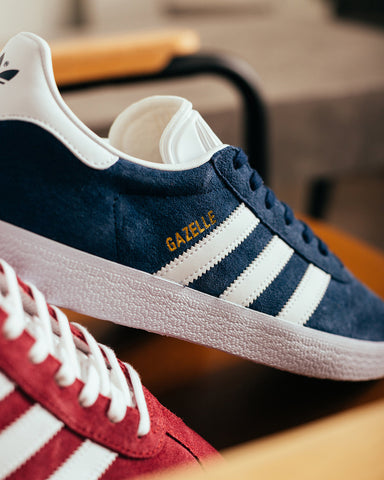

History of the Adidas Gazelle
Chelsie Rendon
HISTORY OF THE ADIDAS GAZELLE
During the early 1900s, athletics and sports were steadily on the rise and Adolf ‘Adi’ Dassler realized there was an opportunity within the footwear industry that is currently being unfulfilled. In a small town in Germany, Adolf began working in his mother’s laundry room and started making sneakers that could withstand the constant wear and tear of an athlete. He soon recruited help from his brother, Rudolf, and after World War 1 the duo official launched, ‘Dassler Brothers Shoe Factory.’ In 1924 when they originally opened their business, they started to see traction but they wanted more and pursued a bigger aspiration. So in 1936, they pleaded with U.S. sprinter Jesse Owens to wear a pair of their shoes during the Summer Olympics. It was this decision that made their brand a worldwide phenomenon as Owens took home four Olympic gold medals that season. As they rose in fame, their personal relationship started to tremble eventually leading to their official separation in 1947. Rudolf would then later create Puma and Adolf ‘Adi’ Dassler would transform the current state of Dassler Brothers Shoe Factory into what we know today as Adidas. To learn more about the upbringing of Adidas, click here to read The History of The Three-Stripes editorial.

When Adidas officially became its own entity, it was difficult to gain footing as they were initially known by another name. After continuously competing against his brother, Adi would then obtain the iconic 3 stripe logo and showcase it to the world during the 1952 Summer Olympics. This was immensely memorable and gave Adidas a headstart within the footwear community. Since then, Adidas has continued to rise within the ranks and showcase classic shoes that are now a part of many closets to this day. One of these silhouettes is known as the Adidas Gazelle; initially made for the track, the sneaker has evolved into a lifestyle silhouette that can be worn in a variety of settings. Making its debut in 1966, the Gazelle evolved throughout the sports realm. Initially made for running, Adidas titled the sneaker after the animal as the gazelle is best known for its long strides.
During this time the sneaker stood out completely as it was the first Adidas sneaker to be made from suede in comparison to the traditional leather counterparts. Many adored this transformation as it made sneakers lightweight without compromising on protection. In addition to the unique upper, the outsole introduced new possibilities of comfort. The original blue version introduced pocket air bubbles within the grooves for a responsive experience during indoor games while the red variant highlighted a non-slip sole for optimal traction on a variety of terrains. By the 70s, the sneaker once again evolved into becoming a go-to athleisure and casual silhouette. The iconic shoe would become heavily worn within Europe and by the 90s, many of the most notable names within the UK could be seen wearing the silhouette; Oasis, Robbie Williams, and the Spice Girls just to name a few.

The Gazelle would continue to prevail but it wasn’t until 2016 when its traction skyrocketed once again as Adidas re-incarnated the 1991 version. This evoked a sense of nostalgia for many as it was an iconic culture piece during that time. This reintroduction reminded those of their childhood as Adidas re-introduced the classic colorways for a limited time. Fast-forwarding to the present day, the Gazelle is still highly regarded as even more notable names can be seen sporting the shoe. G-Eazy, Kanye West, Nick Young, and Rita Ora can be seen casually wearing the staple design. Adidas Originals also continuously introduces upcoming colorways and collaborations of the famed sneaker. Some of the previous partnerships include Neighborhood, Slam Jam, United Arrows, Noah, and even the Star Wars franchise. The style has withstood the trials of fashion and has become a staple design within many collectors’ lineups.
To grab a closer look at the most recent colorways of the signature shoe, click here.




























